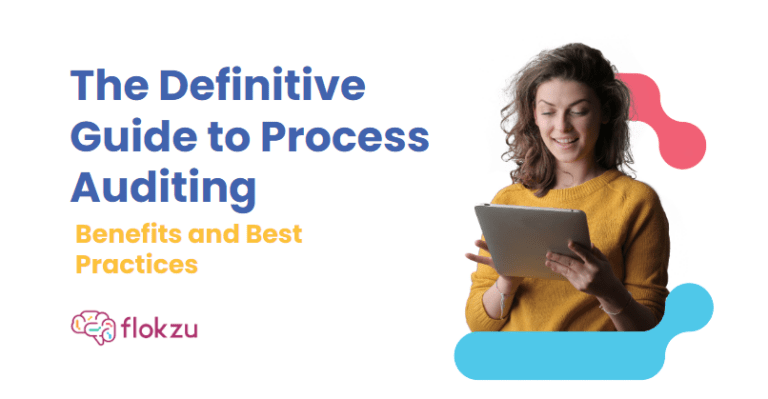Process auditing has become an indispensable tool in today’s dynamic business environment, where companies strive for continuous improvement and optimal efficiency. This guide aims to provide a concrete vision, supported by available software tools, of the audit of automated administrative processes with a BPM Suite, its importance, the different types of audits, the use of automation and the best practices to streamline operations and achieve organizational excellence.
What is a process audit?
A process audit assesses an organization’s processes to evaluate their effectiveness, efficiency and compliance with established standards or guidelines. It involves examining processes, identifying inefficiencies and recommending improvements to increase productivity and quality.
The main components of a process audit are:
- Review of process documentation
- Evaluation of process execution
- Identification of process bottlenecks
- Evaluation of process outputs and results
- Recommendations for process optimization
Importance of process audits
Process audits are key in driving operational excellence and ensuring continuous improvement in an organization. Some of the main advantages of performing process audits are:
Improved process efficiency
Companies can identify inefficiencies and streamline operations by analyzing existing processes, leading to increased productivity and reduced costs.
Improved compliance
Process audits help organizations meet regulatory requirements and industry standards, mitigating the risk of non-compliance and potential penalties.
Improved decision making
Data obtained from process audits enables decision-makers to make informed decisions for process optimization and resource allocation.
Improved customer satisfaction
Process efficiency translates into better products or services, increasing customer satisfaction and loyalty.
Employee empowerment
Process audits engage employees, fostering a culture of accountability, ownership and continuous improvement.
Audit types
Process audits can take various forms, depending on their scope and objectives. Some common types of audits are:
- Internal audits: These audits are conducted by internal teams or auditors within the organization to evaluate internal processes and compliance.
- External audits involve independent auditors or third-party agencies evaluating an organization’s processes and performance.
- Compliance audits: These audits ensure compliance with regulatory requirements, industry standards and internal policies.
- Systems audits: Systems audits assess an organization’s integrated management systems, such as ISO 9001, ISO 14001 or ISO 27001.
Internal vs. external audits
Internal and external audits have different purposes and unique advantages:
Internal audits
- Performed by internal staff or qualified auditors of the organization.
- Facilitate continuous process improvement and corrective action.
- Improve communication and collaboration within departments.
- Promote a culture of continuous improvement and employee engagement.
External audits
- Performed by independent auditors or external agencies.
- Provide an unbiased assessment of processes and compliance.
- Validate the organization’s adherence to external standards or regulations.
- Increase stakeholder confidence and credibility.
Process Audits vs. Business Process Audits
To fully understand the power of advanced business process audits, it is crucial to distinguish them from regular process audits. While the latter usually focus on assessing isolated processes, business process audits are extended to take a holistic view of the organization’s operational ecosystem. In this way, they enable a comprehensive assessment of interdependent processes and their impact on the company’s overall performance. This integration of different areas is made possible by digitizing processes through a BPM Suite.
Three essential steps for an effective advanced business process audit
Data preparation
Data is the cornerstone on which effective business process audits are built. As auditors, we recognize the value of thorough data preparation. Accurate and complete data collection lays the foundation for in-depth analysis and informed decision-making. Metrics or Key Performance Indicators (KPIs), such as cycle time, errors, processing time and request status, emerge as critical touch points in this data-driven journey to improvement. An automation tool, such as Flokzu, generates most of these KPIs, making them available from the beginning of the digitization process.
Process analysis
Once the data has been collected, the auditors embark on the process analysis phase. This involves an examination of workflows, identifying redundancies, inefficiencies and potential areas for improvement. Through keen observation and analytical prowess, we uncover the intricate mechanics of each process, finding the path for transformation and evaluating new technologies.
Corrective actions
Undoubtedly, the ultimate goal of any business process audit is not simply to identify problems but also to devise effective solutions. Corrective actions are the catalysts that drive change and raise the organization’s efficiency. Armed with the information gained from data and process analysis, auditors chart a course of action that targets the root causes of inefficiencies. A well-crafted corrective action plan promises to revamp operations and boost productivity to unprecedented levels. A no-code process management tool allows these corrections and improvements to be introduced faster and at a lower cost.
Best practices for process audits
To ensure the effectiveness and efficiency of process audits, it is essential to follow best practices, such as:
- Standardization: Use standardized audit templates and guidelines to maintain consistency.
- Clear communication: Ensure open communication with auditees and stakeholders.
- Data-driven analysis: Rely on data and evidence-based findings to make informed recommendations.
- Risk-based approach: Prioritize audits based on risk exposure and criticality of processes.
- Continuous improvement: Adopt a culture of continuous improvement and learn from audit results.
Why follow an established process?
Following a structured process for conducting audits is essential for several reasons:
- Consistency: A standardized process ensures consistent and reliable audit results.
- Efficiency: A well-defined process streamlines audit activities and reduces redundancies.
- Thoroughness: A structured approach ensures that all essential aspects of the audit are covered.
- Compliance: Following an established process helps auditors comply with established audit guidelines.
Examples of auditing procedures
Audit procedures vary depending on the type and scope of the audit. Here are some examples of audit procedures commonly used in process audits:
- Process documentation review: Review process manuals, standard operating procedures, and policies. Flokzu, a no-code BPM, has a functionality that allows exporting process documentation, BPMN diagram and relevant information for each task.
- Observation of process execution: Observe the actual execution of processes in real-time.
- Analyze performance metrics: Evaluate process-related metrics and key performance indicators.
- Conduct interviews: Engage with process owners and stakeholders to gather information.
- Testing controls: Evaluate the effectiveness of internal controls and risk mitigation measures.
Example of an audit plan
An audit plan describes the scope, objectives and methodology of the audit. The following is an example of an audit plan for a business process audit:
Audit plan
Audit of the sales order process.
Audit objectives
- Evaluate the effectiveness of the sales order processing system.
- Evaluate compliance with company policies and industry regulations.
- Identify opportunities to improve the speed and accuracy of order processing.
Audit scope
- Sales order processing, from receipt to execution.
- Involvement of sales, logistics and finance departments in the process.
Audit methodology
- Compilation of process documentation, including standard operating procedures and policies.
- Interview process owners and key stakeholders to understand the process flow.
- Observing order processing activities and identifying potential bottlenecks.
- Review order accuracy and lead times against established targets.
- Evaluate internal controls and risk management practices.
- Benchmark the process against industry best practices.
- Propose recommendations to optimize the process.
Conclusion
In conclusion, process auditing is crucial to an organization’s success. By understanding what a process audit entails and adopting best practices, companies can streamline operations, improve efficiency and maintain compliance. Regular process audits enable organizations to adapt to changing environments, increase awareness of their processes, improve efficiency and maintain compliance.
Using Flokzu for process auditing
For organizations looking for a streamlined and automated process auditing solution, Flokzu offers an intuitive and easy-to-use platform. With Flokzu’s Business Process Management tool, you can:
- Design customized audit workflows and checklists tailored to your organization’s needs.
- Automate audit notifications and reminders to ensure timely completion.
- Collaborate seamlessly with auditors and stakeholders in real-time.
- Generate comprehensive audit reports with actionable recommendations.
- Track audit progress and monitor implementation of proposed improvements.
- Generate a complete audit trail from each executed process instance, indicating what tasks were performed, by whom and when.
Frequently Asked Questions
The frequency of process audits can vary depending on the size of the organization, industry and risk exposure. Annual or semi-annual audits are generally common practice, but high-risk processes may require more frequent audits.
Process audits are critical to ensure compliance with regulatory requirements, industry standards and internal policies. They help identify areas of non-compliance and recommend corrective actions.
Organizations can track key performance indicators (KPIs) related to the audited processes to measure the impact of implemented audit recommendations. These KPIs can include process efficiency, error rates, customer satisfaction and compliance metrics.




























